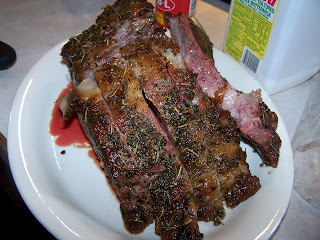You might be thinking, "Why would I want to make my own sour cream?" It is readily available in the grocery stores for not a whole lot of cash. There are a few reasons why you might consider making your own. One reason is many commercial dairies add guar gum or gelatine to make the sour cream even thicker or things to make it last longer. Or, you might have bought heavy cream for a recipe and have 1/2 c. left over. It just sits in your fridge because you aren't sure what to do with it.
I started making my own sour cream on a regular basis when I started buying pasteurized, non-homogenized milk. The cream rises to the top and then I can skim it off and make sour cream. This is not only tasier!, but also eco-friendlier. I'm not wasting money on packaging or filling up landfills with plastic containers. (Food for thought, it still takes 5 years for a cardboard milk container to biodegrade.) Here's a bonus too: it is SUPER easy to make!
If the thought of souring your own cream just seems a little gross, I ask you, how do you think commercial dairies do it? We get separated from the process and don't realize that what is done in a huge factory can be done in your own kitchen. Our ancestors made sour cream by letting the fresh raw cream just sit out until it reach the desired degree of sourness/thickness. Here is how eHow.com describes the modern, commercial sour cream development.
"The pasteurized cream is inoculated with bacteria that come from lactic acid. The inoculated cream is allowed to ripen for 14 to 16 hours at 72 degrees F. During this time, the bacteria grows, fermenting the cream in the process. This process is also called "souring," which is how sour cream got its name. Souring makes the cream thick and sour. Then the cream is chilled for 12 to 48 hours. Once the cream is soured to the desired level, it is pasteurized to kill the bacteria.
The process described above is easily done in the home kitchen with yummy results! Let's reclaim sour cream!
You will need: heavy or light cream, buttermilk, and a glass container with a lid.
Printable Recipe
Here I have two cups of cream. (This is actually raw cream I was able to purchase at a local co-op.)
If you are using raw cream or non-homogenized milk, you might want to let the cream sit in a gravy separator for several hours. The milk will sink to the bottom and then you can just pour it off. (If any milk is left, it will make the sour cream a little lumpy. I will explain later how to fix this.) If you are using straight cream that you bought at the store, then skip this step. Pour the cream into a clean glass jar that has a lid.
Now we need to find a source of lactic acid. The buttermilk you have in your fridge is a great source of lactic acid.
You may not be able to see in this pic, but the first ingredient in my Lowfat Cultured Buttermilk is cultured low fat milk. Cultured in this case means lactic acid. I nearly always have buttermilk on hand, it's my secret weapon for lots of different recipes. To sour our cream, we need to add some buttermilk to it. For each cup of cream, you need one tablespoon of buttermilk. So to the two cups of cream in my jar, I added 2 T. of buttermilk.
Stir it up, put the lid on it and store it on the kitchen counter overnight.
In the morning, you should have beautifully thickened sour cream.
The only thing to do now is put a lid on it, label it and put it in the fridge.
I have to admit that this morning when I went to open my container of sour cream it was lumpy and still liquidy.
I realized that I didn't get all the milk out when I separated it the day before. This is easily fixed. Take a large strainer and line it with one layer of cheesecloth. Pour the sour cream in the cheesecloth and let it sit for a while, giving it the occasional stir. The liquid will drain out and leave you with the yummy sour cream you desire.
I ended up pouring off about a half a cup of liquid. Next time, I'll make sure that I take the time to let the milk and cream fully separate. I hope you get a chance to try this method.
































